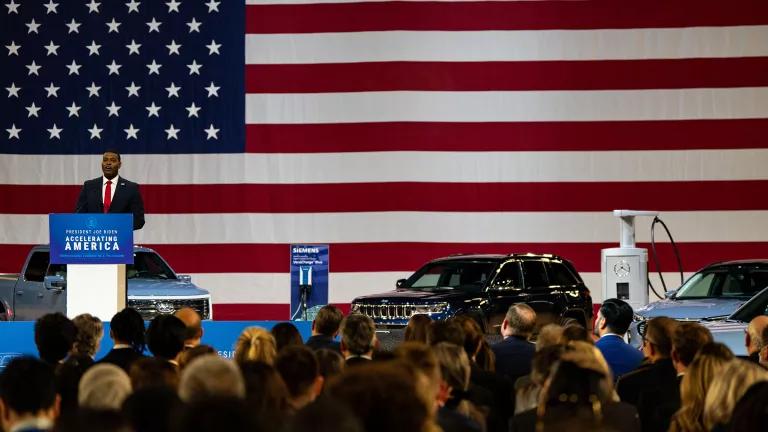EVs Will Drive North Carolina to Cleaner Air for Everyone
A new report indicates that North Carolina would see $150 billion in cumulative net societal benefits by 2050 through the adoption of The Advanced Clean Cars II, Advanced Clean Trucks, and the Nitrogen Oxide (NOx) Omnibus Rules.

The transportation sector is the largest source of greenhouse gas emissions in North Carolina. To reduce this pollution and improve residents’ health, the state should adopt standards that increase the number of electric trucks, buses, and cars (EVs) that are on our roads, as well as implement additional policies that support clean transportation. Improving the health of all North Carolinians, while reducing transportation sector pollution, is not just the right thing to do but makes sense economically.
A new report by ERM, commissioned by NRDC, indicates that North Carolina would see $150 billion in cumulative net societal benefits by 2050 through the adoption of three main “core policies”: The Advanced Clean Cars II, Advanced Clean Trucks, and the Nitrogen Oxide (NOx) Omnibus Rules.
- Advanced Clean Cars II – This rule works to reduce smog-causing pollutants and greenhouse gas emissions from the transportation sector while also requiring vehicle manufactures to sell an increasing number of electric vehicles in adopting states. California is currently in the process of finalizing the second iteration of this program, but 15 states have previously adopted the “Advanced Clean Cars I” program.
- The Advanced Clean Truck Rule (ACT)—The ACT Rule requires an increasing percentage of new trucks purchased in the State to be EVs beginning in the 2025 model year.
- The NOx Omnibus Rule— this regulation requires an additional 75 percent reduction in NOx emissions from engines in new gasoline and diesel trucks sold between model year 2025 and 2026, and a 90 percent reduction for trucks being sold beginning in the 2027 model year.
While these standards are important foundations for the state to reduce emissions from the transportation sector, North Carolina will need to implement and adopt additional policies and programs to support the “core policies” ensuring all communities will benefit from a clean transportation future.
Clean Vehicles provide significant benefits to North Carolina
The analysis from ERM highlights the major benefits that North Carolina can anticipate through the adoption of the Advanced Clean Cars II, ACT, and NOx Omnibus Rules. The report models three scenarios:
- The “Medium Scenario” adopted the Biden Administration’s EV goal of achieving 50 percent of new passenger vehicles and light-duty trucks sold to be zero emission vehicles by 2030 and includes North Carolina fully adopting the ACT and NOx Omnibus rules.
- The “High Scenario” adopted the proposed ACC II regulation and included the full adoption of both the ACT and NOx Omnibus Rules. Additionally, the scenario increases the ACT program overtime resulting in 100 percent of all M/HDV sales being ZEV after 2040.
- A “High (Clean Grid) Scenario” used the same vehicle adoption trajectories as the High Scenario, but also includes a clean electric grid mix based on North Carolina’s HB951 Legislation.

The report found that cumulative benefits from these scenarios could reach $150 billion by 2050, including:
- Approximately $92 billion in net savings from annual incremental EV purchase costs for both LDVs and M/HDVs, annual incremental charging infrastructure costs, annual incremental low NOx (LNOx) ICE vehicle purchase costs, savings from vehicle maintenance costs, and annual charging infrastructure maintenance costs;
- Almost $52 billion in the monetized value of GHG, NOx, and PM reductions; and
- Over $7 billion in utility net revenue.
Additional benefits from these scenarios include:
- $12.5 billion in public health benefits.
- Preventing over 1,000 deaths, 670 hospitalizations, and 630,000 restricted activity days.
- $1.2 billion in annual charging infrastructure investments.
- Vehicle lifetime fuel savings of $6,000 for cars and $34,000 for trucks.
Environmental Entrepreneurs (E2) also released a factsheet highlighting the benefits of the rules if the State was to adopt Advanced Clean Cars, Advanced Clean Trucks, and the Heavy-Duty Omnibus rules.
Policy Roadmap to Support Electrification
In addition to the aforementioned standards and regulations, North Carolina will need to adopt additional policies and programs to support the transition to an electric transportation future. In particular, the report pays close attention to equity concerns and provides suggestions to address them across the various sections. The ERM report also considers current barriers to widespread EV adoption and provides recommendations on complementary policies and programs that the state should consider, in addition to adoption of ACCII, ACT, and the NOx Omnibus Rule. Recommendations include:
Infrastructure Development:
- Develop a charging rebate program
- Develop effective curbside charging and parking strategies
- Partner with utilities to offer technical expertise
- Ensure sustained engagement with leaders in disproportionately impacted communities at all stages of the planning process
Vehicle Financing:
- Allocate funding across the truck sector to address unique sector needs
- Introduce flexibility to finance vehicles and infrastructure
- Adopt a rebate program to offset the upfront costs of EVs
- Provide incentives for used electric vehicles
Education and Outreach
- Develop a workplace ZEV training program
- Establish an EV infrastructure toolkit
State Leadership
- Electrify transit and public service fleets
- Encourage low-emission travel
North Carolina has already made important strides towards a clean transportation future for everyone, including Governor Cooper’s Executive Order No. 246, North Carolina’s Transformation to a Clean, Equitable Economy. This executive order establishes a goal of at least 1,250,000 new ZEV vehicles by 2030. It also created a new ZEV sales target that requires at least 50 percent of in-state sales of new vehicles to be zero emission by 2030.
These are important first steps, but to achieve the benefits that the ERM report identified, the Tar Heel State needs to move forward not only with the “Core Policies” but also additional complementary policies that establish equitable programs and drive the state towards clean, electric trucks and buses.





